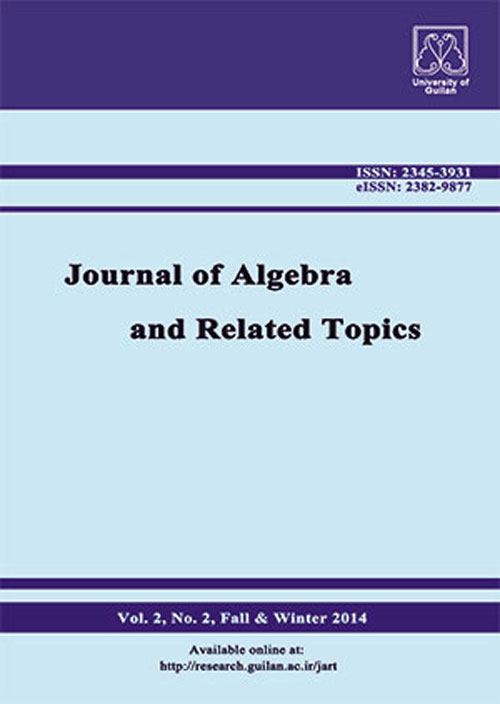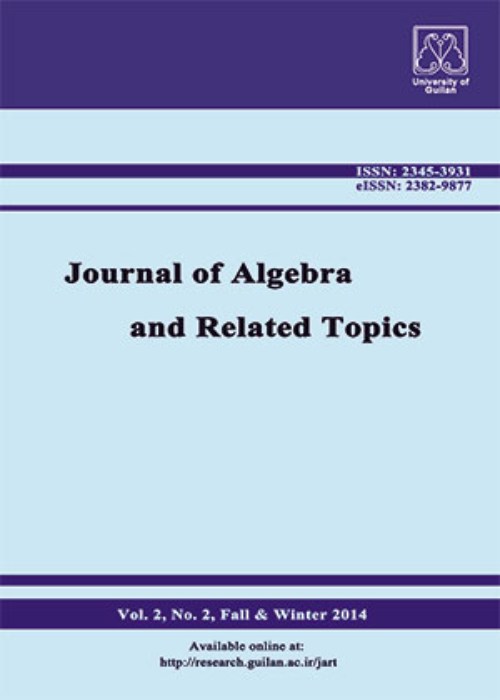فهرست مطالب

Journal of Algebra and Related Topics
Volume:9 Issue: 1, Spring 2021
- تاریخ انتشار: 1400/03/30
- تعداد عناوین: 12
-
-
Pages 1-19This paper is a continuation of study rings relative to rightideal, where we study the concepts of regular and local ringsrelative to right ideal. We give some relations between $P-$local($P-$regular) and local (regular) rings. New characterizationobtained include necessary and sufficient conditions of a ring $R$to be regular, local ring in terms $P-$regular, $P-$local ofmatrices ring $M_{2}(R)$. Also, We proved that every ring is localrelative to any maximal right ideal of it.Keywords: P-idempotents, Regular, P-regular rings, Local, P-local rings, semi-potent rings
-
Pages 21-29Let $R$ be a commutative ring and let $Bbb A(R)$ bethe set of all ideals of $R$ with nonzero annihilator.The annihilator-ideal graph of $R$ is defined as the graph${A_I}(R)$ with the vertex set $Bbb A(R)^*=Bbb A(R)setminus{0}$ and twodistinct vertices $I$ and $J$ are adjacent if and only if${rm Ann}_R(IJ)neq{rm Ann}_R(I) cup{rm Ann}_R(J)$. In this paper, perfectness of${A_I}(R)$ for some classes of rings is investigated.Keywords: Annihilator-ideal graph, Perfect graph, Chromatic number, Clique number
-
Pages 31-50
In this paper, the notions of $n$-fold obstinate and $n$-fold fantastic (pre)filterin $EQ$-algebras are introduced and the relationship among $n$-fold obstinate, maximal, $n$-fold fantastic, and $n$-fold (positive) implicative prefilters are investigated. Moreover, the quotient $EQ$-algebra induced by an $n$-fold obstinate filter is studied and it is proved that the quotient $EQ$-algebra induced byan $n$-fold fantastic filter of a good $EQ$-algebra with bottom element $0$ is an involutive $EQ$-algebra. Finally, the relationships between types of $n$-fold filters in residuated $EQ$-algebras is shown by diagrams
Keywords: EQ-algebra, n-fold obstinate (pre)filter, n-fold fantastic (pre)filter -
Pages 51-60In this paper, we introduce a generalized form of the class of topological rings, namely -topological rings by using -open sets which itself is a generalized form of open sets. Translation of open(closed) sets and multiplication by invertible elements of open(closed) sets of the -topological rings are investigated. Some other useful results on -topological rings are also given. Examples of -topological rings which fails to be topological rings are also provided. We further de ne -topological rings with unity in the sequel and presented some results on it.Keywords: beta -open sets, beta -closed sets, beta-topological ring, beta -continuous mappings
-
Pages 61-78
K"ahler-Poisson algebras were introduced as algebraic analogues of function algebras on K"ahler manifolds, and it turns out that one can develop geometry for these algebras in a purely algebraic way. A K"ahler-Poisson algebra consists of a Poisson algebra together with the choice of a metric structure, and a natural question arises: For a given Poisson algebra, how many different metric structures are there, such that the resulting K"ahler-Poisson algebras are non-isomorphic? In this paper we initiate a study of such moduli spaces of K"ahler-Poisson algebras defined over rational functions in two variables.
Keywords: Poisson algebras, rational functions, moduli spaces -
Pages 79-92Let $R$ be a commutative ring with identity and let $M$ be a unitary $R$-module. In this paper, among various results, we prove that if $M$ is a cancellation $R$-module and $L$ is a nonzero simple submodule of $M$, then $L$ is a copure submodule of $M$. Moreover, in this case, if $M$ is co-m, then $M/L$ is also a co-m $R$-module. We investigate various conditions under which the quotient module $M/N$ of a co-m $M$ is also a co-m. We prove that if $M$ is a cancellation Noetherian co-m module, then for every second submodule $N$ of $M$ the quotient module $M/N$ is a co-m $R$-module. We obtain some results concerning socle and radical of co-m modules.Keywords: comultiplication module, Small submodule, quasi-copure submodule
-
Pages 93-108Let $M$ be a module over a commutative ring $R$, $Z_{*}(M)$ be its set of weak zero-divisor elements, andif $min M$, then let $I_m=(Rm:_R M)={rin R : rMsubseteq Rm}$. The annihilator graph of $M$ is the (undirected) graph$AG(M)$ with vertices $tilde{Z_{*}}(M)=Z_{*}(M)setminus {0}$, and two distinct vertices $m$ and $n$ are adjacent if andonly if $(0:_R I_{m}I_{n}M)neq (0:_R m)cup (0:_R n)$. We show that $AG(M)$ is connected with diameter at most two and girth at mostfour. Also, we study some properties of the zero-divisor graph of reduced multiplication-like $R$-modules.Keywords: Annihilator graph, reduced module, multiplication-like module
-
Pages 109-119Let $mathcal{R}_c( L)$ be the pointfree version of $C_c(X)$, the subring of $C(X)$ whose elements have countable image. We shall call a frame $L $ a $CP$-frame if thering $mathcal{R}_c( L)$ is regular. % The main aim of this paper is to introduce $CP$-frames, that is $mathcal{R}_c( L)$ is a regular ring. We give some We give some characterizations of $CP$-frames and we show that $L$ is a $CP$-frame if and only if each prime ideal of $mathcal{R}_c ( L)$ is an intersection of maximal ideals if and only if every ideal of $mathcal{R}_c ( L)$ is a $z_c$-ideal. In particular, we prove that any $P$-frame is a $CP$-frame but not conversely, in general. In addition, we study some results about $CP$-frames like the relation between a $CP$-frame $L$ and ideals of closed quotients of $L$. Next, we characterize $CP$-frames as precisely those $L$ for which every prime ideal in the ring $mathcal{R}_c ( L)$ is a $z_c$-ideal. Finally, we show that this characterization still holds if prime ideals are replaced by essential ideals, radical ideals, convex ideals, or absolutely convex ideals.Keywords: P-frame, CP-frame, regular ring, z-ideal, z-good ring
-
Pages 121-129Let $(G, +)$ be a finite group, written additively with identity 0, but not necessarily abelian, and let $H$ be a nonzero, proper subgroup of $G$. Then the set $M = {f : G to G | f(G) subseteq H hbox{and} f(0) = 0 }$ is a right, zero-symmetric nearring under pointwise addition and function composition. We find necessary and sufficient conditions for $M$ to be a ring and determine all ideals of $M$, the center of $M$, and the distributive elements of $M$.Keywords: Abelian, distributive, center, ideal, zero-symmetric
-
Pages 131-141The $Gamma$-semihyperring is a generalization of the concepts of a semiring, a semihyperring and a $Gamma$-semiring. In this paper, the notions of completely prime ideals and prime radicals for $Gamma$-semihyperring are introduced and studied some important properties accordingly. We also introduced the notions of $m$-system and complete $m$-system. Then characterizations of prime ideals and completely prime ideals of $Gamma$-semihyperring with the help of $m$-system and complete $m$-system has been taken into account. It is our attempt to find a bridge between semiprime (completely semiprime) ideals and prime (completely prime) ideals of a $Gamma$-semihyperring.Keywords: m-system, complete m-system, additively idempotent $Gamma$-semihyperring
-
Pages 143-158Let $R$ be a Krasner hyperring and $M$ be an $R$- hypermodule. Let $psi: S^{h}(M)rightarrow S^{h}(M)cup {emptyset}$ be a function, where $S^{h}(M)$ denote the set of all subhypermodules of $M$. In the first part of this paper, we introduce the concept of a secondary hypermodule over a Krasner hyperring. A non-zero hypermodule $M$ over a Krasner hyperring $R$ is called secondary if for every $rin R$, $rM=M$ or $r^{n}M=0$ for some positive integer $n$. Then we investigate some basic properties of secondary hypermodules. Second, we introduce the notion of $psi$-secondary subhypermodules of an $R$-hypermodule and we obtain some properties of such subhypermodules.Keywords: Krasner hyperring, hypermodule, secondary hypermodule, $psi$-secondary subhypermodule
-
Pages 159-167Let $(A,mathfrak{M})$ be a noetherian local ring with infinite residue field $A/ mathfrak{M}$ and $I$ be a $mathfrak{M}$-primary ideal of $A$. Let $f = (I_{n})_{nin mathbb{N}}$ be a good filtration on $A$ such that $I_{1}$ containing $I$. Let $sigma$ be a semi-prime operation in the set of idealsof $A$. Let $lgeq 1$ be an integer and $(f^{(l)})_{sigma} = sigma(I_{n+l}):sigma(I_{n})$ for all large integers $n$ and$rho^{f}_{sigma}(A)= min big{ nin mathbb{N} | sigma(I_{l})=(f^{(l)})_{sigma}, for all lgeq n big}$. Here we show that, if $I$ contains an$sigma(f)$-superficial element, then $sigma(I_{l+1}):I_{1}=sigma(I_{l})$ for all $l geq rho^{f}_{sigma}(A)$. We suppose that $P$ is a prime ideal of $A$ and there exists a semi-prime operation $widehat{sigma}_{P}$ in the set of ideals of $A_{P}$ such that $widehat{sigma}_{P}(JA_{P})=sigma(J)A_{P}$, for all ideal $J$ of $A$. Hence $Ass_{A}big( A / sigma(I_{l}) big) subseteq Ass_{A}big( A / sigma(I_{l+1}) big)$, for all $l geq rho^{f}_{sigma}(A)$.Keywords: Noetherian ring, good filtration, semi-prime operation, prime divisors, superficial elements


